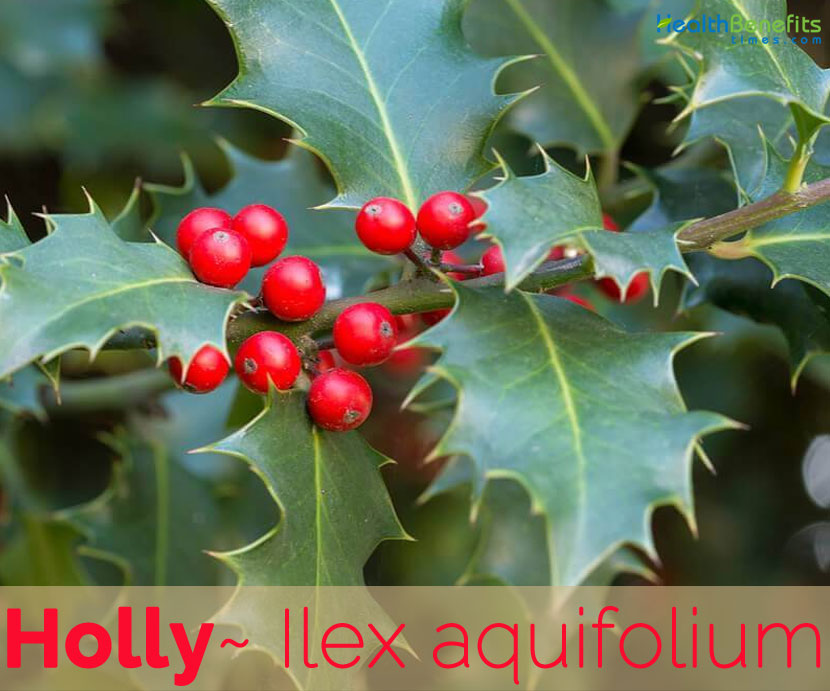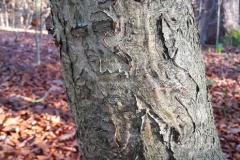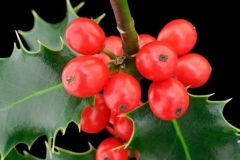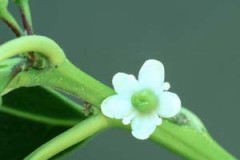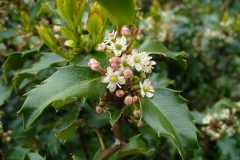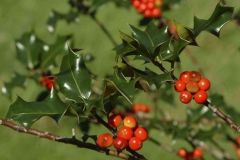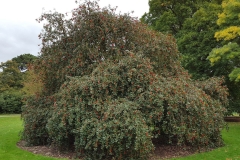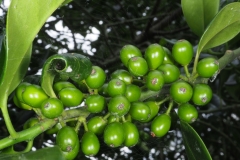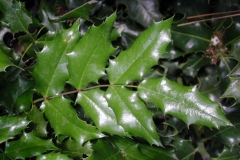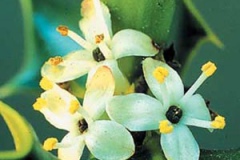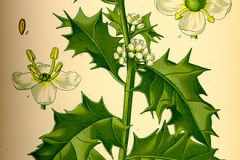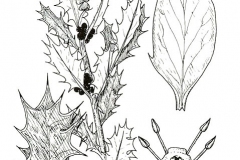American holly, Appalachian tea, Cassena, Christmas berry, Deer berry, English holly, Holly, Indian black drink, Indian holly, Oregon holly, Yaupon, European holly, Common Holly, prickly-leaved holly and variegated holly are some of the popular common names of the plant. Genus name comes from the Latin name Quercus ilex for holm oak in reference to the foliage similarities (holm oak and many of the shrubs in the genus Ilex have evergreen leaves). Specific epithet comes from the Latin word acus meaning needle and folium meaning leaf in reference to the spiny leaves.
Holly Facts
| Holly Quick Facts | |
|---|---|
| Name: | Holly |
| Scientific Name: | Ilex aquifolium |
| Origin | Northern Africa, western and southern Europe and western Asia |
| Colors | Green when young turning to bright red to orange |
| Shapes | Berry like drupe (stone fruit), about 6–10 mm in diameter. They each contain four seeds, are usually borne in clusters, and are eaten by birds which disperse the seeds. |
| Taste | Bitter, acrid |
| Health benefits | Beneficial for intermittent fevers, rheumatism, catarrh, pleurisy, jaundice, smallpox, whooping-cough, fever, bronchitis, cold and digestive disorders |
| Name | Holly |
|---|---|
| Scientific Name | Ilex aquifolium |
| Native | Northern Africa (i.e. Algeria, Morocco and Tunisia), western and southern Europe (i.e. the UK, France, Portugal, Spain, Albania, Bulgaria, Italy and Yugoslavia) and western Asia (i.e. Iran, Syria and Turkey). |
| Common Names | American holly, Appalachian tea, Cassena, Christmas berry, Deer berry, English holly, Holly, Indian black drink, Indian holly, Oregon holly, Yaupon, European holly, Common Holly, prickly-leaved holly, variegated holly |
| Name in Other Languages | frikaans: Holly Amharic: Holī (ሆሊ) Albanian: Ashe, ashja, ilqe Arabic: Huli (هولي) Armenian: P’sharmav (փշարմավ) Azerbaijani: Holly Basque: Gorostiak Belarusian: Padub (падуб) Bengali: Ciraśyāmala gulmabiśēṣa (চিরশ্যামল গুল্মবিশেষ) Bosnian: Zelenika Bulgarian: Djel (джел), zelenika (зеленика), ileks (илекс), samodivski chishmir (самодивски чишмир) Catalan: Arbre de mal fruit, Boix grèvol, Coscoll de vesc, Grèvol, greu, greuler, grèvol de visc Cebuano: Holly Chichewa: Holly Chinese: Dōngqīng (冬青) Corsican: Agliu Croatian: Božikovina, božika, Czech: Cesmína, cesmína ostrolistá, Danish: Kristtorn, Almindelig kristtorn Dutch: Hulst, groene hulst English: English holly, Holly, European holly, English holl, Christmas Holly, Common Holly, English Holly, prickly-leaved holly; variagated holly Esperanto: Ilekso Estonian: Astelpõõsas Filipino: Holly Finnish: Orjanlaakeri French: Agrifous, agriou, bois franc, grand pardon, gréou, grifeuil, housson, houx, houx à feuilles epineuses, houx commun, meslier épineux Frisian: Hulst Galician: Acivro Georgian: Holly German: Gemeine Stechpalme, gemeiner Hülst, gewoehnliche Stechpalme, Hülsdorn, Hülsstrauch, Stechholder, Stechpalme, Hülse, Hulst, Stechhülse Greek: Prínos (πρίνος), Ílix (Ίληξ), lióprino (λιόπρινο) Gujarati: Hōlī (હોલી) Haitian Creole: Holly Hausa: Holly Hawaiian: Holly Hebrew: הולי Hindi: Hollee (होल्ली) Hmong: Holly Hungarian: Magyal, Közönséges magyal Icelandic: Holly Igbo: Holly Indonesian: Holly Irish: Cuileann Italian: Agrifoglio, agrifolio, alboro spinoso, aquifolio Japanese: Horī (ホリー), seiyou hiiragi Javanese: Holly Kannada: Hali (ಹಾಲಿ) Kazakh: Kholli (Холли) Khmer: Holly Kinyarwanda: Holly Korean: Holli (홀리) Kurdish: Pîroz Kyrgyz: Holly Lao: Holly Latin: Ilex Latvian: Aslapainā palma Lithuanian: Bugienis Luxembourgish: Holly Macedonian: Kholi (Холи) Malagasy: Holly Malayalam: Hēāḷi (ഹോളി) Malay: Holly Maltese: Holly Maori: Holly Marathi: Holee (होली) Mongolian: Kholli (Холли) Myanmar (Burmese): Holly Nepali: Holee (होली) Netherlands: Europese hulst, hulst Norwegian: Kristtorn, Beenwedd, Mar-torn, beinved Occitan: Fouito-pastre, Grefuèlh, Gréfol, Grífol Odia: ହୋଲି Pashto: هولی Persian: راج Polish: Ostrokrzew, ostrokrzew kolczasty Portuguese: Azevinho, acevinho, acevinho-espinhoso, aquifólio, cibro, espinha-sempre-verde, pica-folha, pica-rato, teio, vidreiro, visqueiro, xardo, xardón, zebro Punjabi: Hōlī (ਹੋਲੀ) Romanian: Ilice, laur Russian: Padub (падуб), padub ostrolistnyy (падуб остролистный) Samoan: Paia Scots Gaelic: Cuileann Serbian: Zelenika (зеленика), bozhika (божика), ostrolist (остролист), chesvina (чесвина) Sesotho: Natalie Shona: Holly Somali: Anfaca Swahili: Holly Sindhi: پاڪ Sinhala: Sākayaṭat (ශාකයටත්) Slovak: Svätý, cezmína ostrolistá Slovenian: Holly, navadna bodika Spanish: Acebo, muerdago, Agrifolio, Cardonera, Xardón, cardon boixgrevol; grèvol, alebro, aquifolio, boix grevol, cebro, crévol, gorostiza Sundanese: Holly Swedish: Järnek, Kristtorn Tatar: Kholli (холли) Tajik: Kholli (Холли) Tamil: Hōli (ஹோலி) Telugu: Hāllī (హాల్లీ) Thai: T̂n ḥxl lī (ต้นฮอลลี) Turkish: Cobanpüskülü Turkmen: Holly UK: Holm, hulver bush Ukrainian: Padub (падуб) Urdu: ہولی Uyghur: Holly Uzbek: Xolli Vietnamese: Hoa huệ Welsh: Celyn Xhosa: Ngcwele Yiddish: Khali (כאַלי) Yoruba: Holly Yugoslavia (Serbia and Montenegro): Bodika, bozikovina, bozjiles Zulu: Holly |
| Plant Growth Habit | Large, slow-growing evergreen tree or shrub |
| Growing Climates | Forests, forest edges, scrub- and woodland, hedges, thickets, second-growth forest, roadsides, open ground |
| Soil | Prefers acid, sandy or gravelly loam soils and found in most well-drained soil |
| Plant Size | 10–25 m (33–82 ft) tall with a woody stem as wide as 40–80 cm (16–31 in), rarely 100 cm (39 in) or more, in diameter |
| Bark | Bark of the young branches is green and shiny but light gray on older branches and stems |
| Stem | Younger stems are green and covered in fine hairs (i.e. finely pubescent), while older stems quickly become hairless (i.e. glabrous). |
| Wood | Hard and dense and is often used for wood cutting |
| Twigs | Twigs are greenish to purplish |
| Leaf | Dark green, thick, glossy, ovate or elliptic, 5-12 cm long, 2.5-5.5 cm wide, glabrous, margins usually thickened, undulate, regularly or irregularly toothed, the teeth stiff, spreading, spinose, rarely entire |
| Flowering season | May to June |
| Flower | Flowers are small, white, fragrant, and found in clusters |
| Fruit Shape & Size | Berry like drupe (stone fruit), about 6–10 mm in diameter. They each contain four seeds, are usually borne in clusters, and are eaten by birds which disperse the seeds |
| Fruit Color | Green when young turning to bright red to orange |
| Seed | Light brown or yellowish seeds are either smooth or ribbed |
| Propagation | By seed and sometimes also vegetatively by suckering and layering |
| Taste | Bitter, acrid |
| Plant Parts Used | Leaves, berries, bark |
| Lifespan | About can live 500 years, but usually does not reach 100 |
| Season | August to October |
| Culinary Uses |
|
Plant Description
Holly is a large, slow-growing evergreen tree or shrub that normally grows about 10–25 m (33–82 ft.) tall with a woody stem as wide as 40–80 cm (16–31 in), rarely 100 cm (39 in) or more, in diameter. The plant has a pyramidal crown, which branches from the base. The bark of the young branches is green and shiny but light gray on older branches and stems. The wood is hard and dense and is often used for wood cutting. Twigs are greenish to purplish. The plant is found growing in Forests, forest edges, scrub- and woodland, hedges, thickets, second-growth forest, roadsides and open ground. The plant prefers acid, sandy or gravelly loam soils and found in most well-drained soil. The younger stems are green and covered in fine hairs (i.e. finely pubescent), while older stems quickly become hairless (i.e. glabrous).
Leaves
The thick and leathery leaves are alternately arranged on the stems and are borne on stalks (i.e. petioles) 5-15 mm long. These leaves are 5–12 cm long and 2–6 cm wide and are roughly oval (i.e. oblong-elliptic) in shape with wavy (i.e. undulate) margins and pointed tips (i.e. acute apices). In the young and in the lower limbs of mature trees, the leaves have three to five sharp spines on each side, pointing alternately upward and downward, while leaves of the upper branches in mature trees lack spines and may even have entire and flat margins. Their upper leaf surfaces are dark green and glossy, while their undersides are paler in color and duller in appearance. Leaf margin may be undulate with spines, especially in the lower part of the tree.
The leaves have neither taste nor odor. They remain attached to the tree for several years, and when they fall, defy for a long time the action of air and moisture, owing to their leathery texture and durable fibers, which take a long time to decay.
Flowers
Small flowers are about 8 mm across and are usually borne in three-flowered clusters (occasionally 1-6 flowers in each cluster), which are thickly arranged into larger clusters in the leaf forks (i.e. axils). The plant is dioecious, meaning that there are male plants and female plants. The sex cannot be determined until the plants begin flowering, usually between 4 and 12 years of age. Separate male and female flowers are borne on separate plants. All flowers are borne on very short stalks (i.e. pedicels) up to 2 mm long. They have four tiny sepals which are about 1.5 mm long and four white or pinkish petals that are 2-5 mm long. The male flowers are yellowish and appear in axillary groups and have four stamens and a rudimentary ovary, while the female flowers are isolated or in groups of three and are small and white or slightly pink, and consist of four petals and four sepals partially fused at the base and have four partially formed stamens (i.e. staminodes) and an ovary topped with a short style and a globular stigma. Flowering occurs mainly during May to June.
Fruit
The fruit only appears on female plants, which require male plants nearby to fertilize them. The fruit is a berry like drupe (stone fruit), about 6–10 mm in diameter. These rounded or egg-shaped fruit turns from green to bright red or bright yellow in color as it matures around October or November. At this time they are very bitter due to the ilicin content and so are rarely eaten until late winter after frost has made them softer and more palatable. They are eaten by rodents, birds and larger herbivores. Each fruit consists of 3 to 4 seeds which do not germinate until the second or third spring. The light brown or yellowish seeds are either smooth or ribbed. The fruit can remain on the tree for the whole winter if not eaten by birds. Blackbirds are often seen flying out of our holly trees this time of the year when they are disturbed by curious dendrologists.
Traditional uses and benefits of Holly
- Holly is little used in modern herbalism.
- Leaves are diaphoretic, expectorant, febrifuge and tonic.
- They are used in the treatment of intermittent fevers, rheumatism, catarrh, pleurisy etc.
- Juice of the fresh leaves has been successfully used in the treatment of jaundice.
- Berries are violently emetic and purgative.
- They have been used in the treatment of dropsy and as a powder they have been used as an astringent to check bleeding.
- Berries are toxic, especially to children, and should not be used medicinally except under professional supervision.
- Root has been used as a diuretic, though there are more effective diuretics available.
- Holly leaves were formerly used as a diaphoretic and an infusion of them was given in catarrh, pleurisy and smallpox.
- They have also been used in intermittent fevers and rheumatism for their febrifugal and tonic properties, and powdered, or taken in infusion or decoction.
- Bark and leaves are good used as fomentations for broken bones.
- In traditional medicine, holly is supposed to be diuretic, a relief from fever, and a laxative.
- In the Forest of Bere (Hampshire) it used to be held that milk drunk from a holly-wood bowl would cure a child of whooping-cough.
- Herb has occasionally been used internally in the form of a hot tea to reduce fever, treat bronchitis, common cold and some digestive disorders.
- It is also thought to be helpful as a blood purifying tonic for chronic rheumatic ailments and disorders.
- They have been used traditionally as an herbal remedy for dropsy or edema (fluid retention).
- Powdered fruits have an astringent (contracting) effect and have been used to halt bleeding.
- Leaves are used to treat include fever, rheumatism and digestive issues.
- Holly leaf extract is occasionally used to combat jaundice, dizziness and emotional problems.
- In some cases, holly is even utilized as a method of fighting heart disease.
- It has been used in colds, pleurisy, intermittent fever, smallpox, rheumatism and diseases that cause jaundice (yellowing of the skin).
- Reduced to powder, berries have been used as astringents to check intestinal bleeding.
- In the central and southern England, holly was used to treat chilblains.
- Tea from the leaves has been used for measles and colds.
- Leaves help treatment for sore eyes and itchy skin.
Other Facts
- It is an excellent hedge plant, tolerating hard clipping and maritime exposure and forming a dense stock-proof shelter.
- It is beautifully white, except at the center of very old trees, and is highly regarded by cabinet makers though it must be well seasoned.
- The heartwood of mature trees is used for printing blocks, engravings, turnery etc.
- The wood makes a good fuel, burning well even when green.
- Wood is used for woodcraft, turnery, handles, sleeves, sticks.
- Its leaves are browsed by mammals and in the past were used as cattle fodder.
- The mucilaginous bark of young shoots is used to produce birdlime.
- It is a subject of music and folklore, especially in the British tradition.
- It is also a popular ornamental shrub or hedge, with numerous cultivars in a range of colors.
- Its white, fine-grained, hard wood is used for decorative carving and was formerly used for mathematical instruments and light machinery components.
- It has even been dyed black and used as a substitute for ebony piano keys.
Precautions
- The fruit and probably other parts of the plant contain saponin and are toxic, causing diarrhea, vomiting and stupor.
- Do not exceed recommended doses.
- Fruits are particularly poisonous to children.
- The fruits are toxic; eating them will cause vomiting and abdominal pain.
- Due to the fruit’s toxic effects, they should not be used internally.
- The fruits are poisonous and consumption of more than five berries can cause digestive disorders, nausea, vomiting, diarrhea, and sleepiness.
- Consuming 20 to 30 berries or more can cause life-threatening inflammation to occur in the digestive system.
References:
https://www.itis.gov/servlet/SingleRpt/SingleRpt?search_topic=TSN&search_value=503154#null
http://www.hear.org/pier/species/ilex_aquifolium.htm
https://pfaf.org/user/Plant.aspx?LatinName=Ilex+aquifolium
https://www.missouribotanicalgarden.org/PlantFinder/PlantFinderDetails.aspx?kempercode=c208
http://www.floracatalana.net/ilex-aquifolium-l
https://www.nps.gov/olym/learn/nature/english-holly.htm
https://www.drugs.com/npp/holly.html
https://www.botanical.com/botanical/mgmh/h/holly-28.html
https://plants.usda.gov/core/profile?symbol=ILAQ80
https://www.invasiveplantatlas.org/subject.html?sub=5744
https://www.cabi.org/isc/datasheet/28487
http://www.tn-grin.nat.tn/gringlobal/taxonomydetail.aspx?id=19670
https://accs.uaa.alaska.edu/wp-content/uploads/Ilex_aquifolium_BIO_ILAQ80.pdf
https://en.wikipedia.org/wiki/Ilex_aquifolium
http://www.theplantlist.net/tpl/record/kew-2860379
https://gd.eppo.int/taxon/ILEAQ


